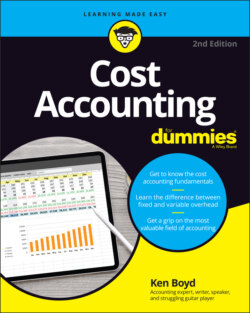Читать книгу Cost Accounting For Dummies - Kenneth W. Boyd - Страница 97
Computing direct costs
ОглавлениеReliable combines the cost of wood, paint, and a waterproofing treatment for the wood. That combined cost represents direct materials. As the manager, you compute direct material costs:
Direct materials = quantity of materials × unit price paid for material
You buy material measured in square feet. The unit cost is the price per square foot (see Chapter 2). Here’s the amount of material needed and the cost:
Direct materials = 600 square feet of material needed × $5 per square foot
Direct materials = $3,000
Your other direct cost is direct labor. Your staff must cut the wood, paint it, waterproof it, and build the fence. Thinking through it further, your staff must measure and dig postholes. They then fill the area around the posts and nail the fence boards onto the posts, all while keeping everything level. Not easy! It takes real skill and planning. As a result, the owners of Reliable Fencing know it’s best to hire skilled people and pay them a reasonable hourly rate.
Your experience as Reliable’s manager allows you to estimate the labor time needed, based on several factors. You consider the square footage of material needed; the length and height of the fence; and any extra work, such as going around those tree trunks. Here’s your formula for direct labor costs:
Direct labor = hours of labor × rate paid for labor
Note a difference in terms: Price is used for materials, and rate is the term used for labor. That distinction comes up in the world of cost variances.
You estimate that 2 people working 20 hours can complete the job. Using these numbers, you determine the labor cost:
Direct labor = hours of labor × hourly rate paid for labor
Direct labor = 2 workers × 20 hours × $20
Direct labor = $800
Consider one more direct cost. You saw a discussion of mileage expense earlier in the chapter. I’ll dust off that formula again and use it here:
Cost per mile = cost per gallon of gas ÷ miles per gallon for the vehicle
Mileage costs = miles needed for client × cost per mile
You calculate 15 miles (round trip) from your office to the job site. However, the work will be completed over several days. You estimate 45 total miles.
Your trucks get 20 miles to the gallon, and your fuel cost is $4 per gallon. It’s not much, but here is the direct cost for mileage:
Cost per mile = $4 gallon of gas / 20 miles per gallon
Cost per mile = 20 cents per mile
Mileage costs = 45 miles needed for client × 20 cents per mile
Mileage costs = $9.00
So you have three direct costs: materials, labor, and mileage. They are direct costs because they can be traced to the cost object: the Johnsons’ fence.
